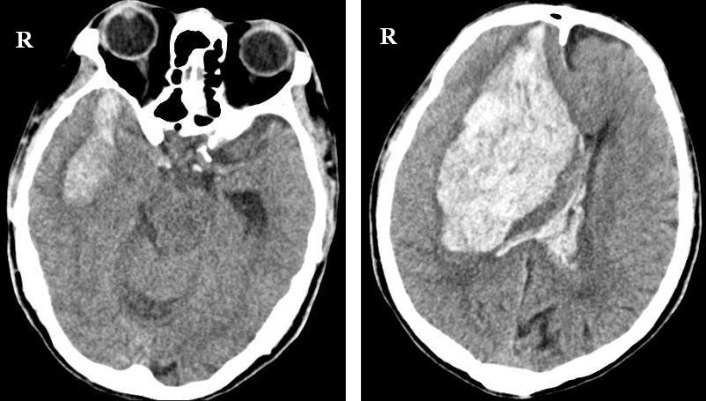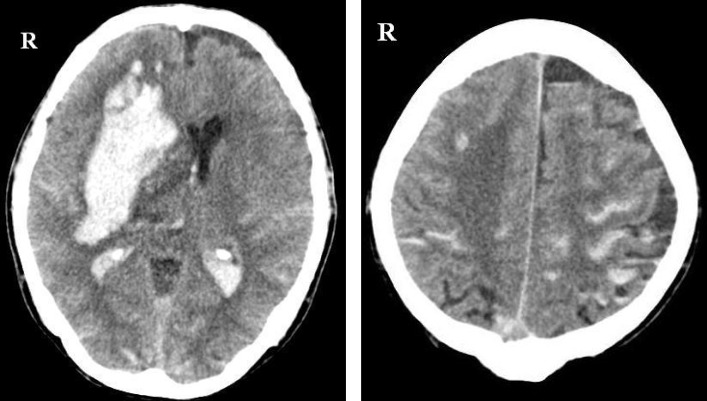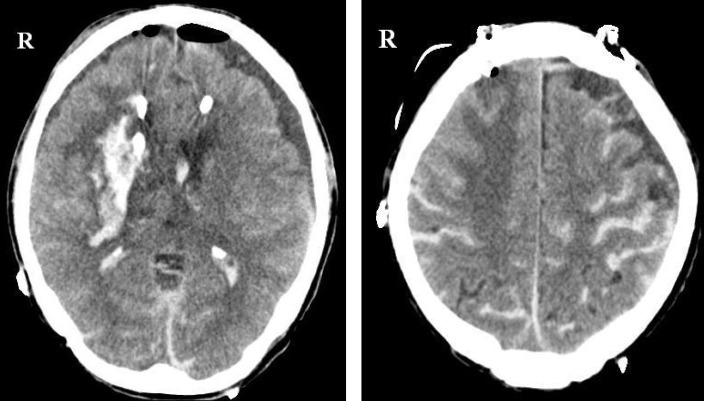Abstract
Rapid reduction of a large acute subdural hematoma has been frequently reported. In my knowledge, however, it was rarely reported that rapid spontaneous reduction occurred in large volume of spontaneous intracerebral hematoma (sICH). We describe a patient with a rapid spontaneous decrease in the volume of a large hematoma. A 73-year-old man presented semi-comatose mentality. Initial brain computed tomography (CT) revealed the huge sICH. An emergency operation was planned, but was not performed due to the refusal of patient's family. Therefore, we decided to treat with conservative therapy. However, follow-up brain CT 16 hours after initial scan showed a remarkable reduction of previous sICH. The mechanism involving the spontaneous rapid decrease of the hematoma is presumed to occur through redistribution in brain atrophy, compression effect from the increased intracranial pressure and dilution through a wash out by the cerebrospinal fluid.
Go to : 
Spontaneous intracerebral hematoma (sICH) occurs as a result of stroke and is characterized by the spontaneous extravasation into the parenchymal tissue of the brain.15) After the initial hematoma, hematoma expansion and perihematoma edema can result in secondary brain damage and a poor prognosis.7) Potential outcomes include prolonged or permanent neurological dysfunction, with neurological deficits evolving over the course of minutes or hours, and persisting for days or weeks. Rapid hematoma enlargement is one of the definite prognostic factors and is often observed in cases involving sICH.16) Furthermore, the outcome of surgical management for huge sICH was associated with a high mortality.6) Rapid spontaneous reduction of a traumatic acute subdural hematoma (SDH) has been frequently reported. However, it was rarely reported that rapid spontaneous reduction occurred in large volume of sICH. In this study, we describe a patient with a rapid spontaneous decrease in the volume of the hematoma and discuss the mechanism involving the spontaneous rapid reduction.
Go to : 
A 73-year-old man was admitted with mental deterioration. He displayed a semi-comatose mentali ty, with a Glasgow Coma Scale (GCS) score of 6 (E1 V2 M3). His pupils were anisocoric with left pupil dilated and did not reflex to light. The initial brain computed tomography (CT) revealed a massive sICH on the right basal ganglia which extended into the frontal lobe, about 210 cc, as well as subarachnoid and intraventricular hemorrhages with a severe midline shift of 2.2 cm (Fig. 1). An emergency decompressive craniectomy and removal of sICH were planned to relieve the subfalcial herniation, but was not performed due to the refusal of the patient's family. Therefore, we decided to treat with a conservative therapy. Follow-up brain CT after 16 hours demonstrated remarkable decrease in the volume of sICH to about 125 cc and showed the decrease of the mass effect and the increase of subarachnoid hemorrhages and intraventricular hemorrhages (Fig. 2). Based on this finding, we planned a surgical procedure for removal of the hematoma and control of intracranial pressure, with consent from the patient's family.
We performed the stereotactic aspiration of sICH and insertion of drainage catheter under general anesthesia. The postoperative CT revealed a remarkable decrease in the volume of the hematoma compared with that of hematoma in the initial CT imaging (Fig. 3). However, there was no improvement in the patient's condition. About a month later, the patient was transferred to a rehabilitation facility as remaining in a stuporous state, with a GCS score of 8 (E2 V2 M4). At the neurologic examination 6 months after initial insult, the patient remained in a bed-ridden state without improvement.
Go to : 
A large volume of sICH is a devastating disease with high rates of mortality and morbidity.7) The classic presentation of sICH includes the sudden onset of a focal neurological deficit that progresses over minutes to hours with accompanying headache, nausea, vomiting, decreased consciousness, and elevated blood pressure.5) The hematoma volume is the most potent predictor of mortality and poor functional outcome in patients with sICH.17) Furthermore, acute expansion of the hematoma within an hour to a day, has been reported as a cause of severe neurologic deterioration and death.14)
In our patient with a huge sICH exhibited a rapid spontaneous reduction in the volume of the hematoma over a very short period of time. The initial brain CT revealed a large basal ganglia hematoma and signs of impending subfalcial herniation. Fortunately, follow-up brain CT 16 hours after initial insult showed a remarkable decrease of the hematoma volume. However, the patient in our study had a large hematoma that decreased in volume within a short time period without improvement of the symptoms attributed to the hematoma.
The rapid expansion of a sICH has been frequently reported.1)14) However, we found limited reports describing the rapid spontaneous decrease in the volume of the hematoma observed in ICH.4) A patient with a petrous bone fracture after trauma showed a spontaneous cure of ICH by drainage into the middle ear.4) However, it was a rare case of traumatic ICH unlike our case. In our case, the ICH was not related to head trauma, so it appears to have been a large hematoma which decreased spontaneously.
However, rapid spontaneous resolution and a decrease in the size of the traumatic acute SDH have frequently been reported.2)3)8)9)11-13)19) The pathophysiology of this phenomenon is not well understood, and many hypotheses have been proposed. Four mechanisms for the rapid resolution of the hematoma have been proposed; dilution and wash out of the hematoma by cerebrospinal flow (CSF) after tearing of the arachnoid membrane; compression and redistribution of the hematoma by acute brain swelling; redistribution of the hematoma through skull fractures; and redistribution of the hematoma to the spinal subdural space.2)3)9-13)18)19) However, the clear mechanism for spontaneous resolution of acute SDH was not identified, especially in that of sICH.
In our case, the patient presented with a basal ganglia hematoma with a margin very close to the subarachnoid and intraventricular spaces. We proposed that pressure from the massive hematoma caused rupture of the adjacent cortical surface and pia mater, resulting in migration of the hematoma into the subarachnoid spaces. In the same way, that resulted in the rupture of the ependymal lining of ventricle and so migration of hematoma into ventricular spaces. On the follow-up brain CT, we found the increased volume of subarachnoid hemorrhages and intraventricular hemorrhages. This finding may support the hypothesis of dilution and wash out of the hematoma by CSF after tearing of the arachnoid membrane. The hematoma mixed with CSF may be a clue in the redistribution process.2)8)11)13)18)20) CSF liquefies the hematoma and the blood clots are redistributed to the subarachnoid and ventricular spaces.11) In the spontaneous rapid reduction of ICH, we suggest that the hematoma mixed with CSF also may be a same mechanism in the distribution process and CSF liquefies the hematoma and the blood clots are redistributed to the subarachnoid and ventricular spaces like several report on spontaneous resolution of acute SDH.
Go to : 
This is a very rare case in which a rapid spontaneous reduction occurred in large volume of sICH. The mechanism involving the rapid decrease of the hematoma is presumed to occur through redistribution in brain atrophy, compression effect from the increased intracranial pressure and dilution through a wash out by the cerebrospinal fluid.
Go to : 
References
1. Bae HG, Lee KS, Yun IG, Bae WK, Choi SK, Byun BJ, et al. Rapid expansion of hypertensive intracerebral hemorrhage. Neurosurgery. 1992; 7. 31(1):35–41. PMID: 1641108.

2. Berker M, Gulsen S, Ozcan OE. Ultra rapid spontaneous resolution of acute posttraumatic subdural hematomas in patient with temporal linear fracture. Acta Neurochir (Wien). 2003; 8. 145(8):715–717. discussion 7. PMID: 14520555.

3. Bortolotti C, Wang H, Fraser K, Lanzino G. Subacute spinal subdural hematoma after spontaneous resolution of cranial subdural hematoma: causal relationship or coincidence? Case report. J Neurosurg. 2004; 4. 100(4 Suppl Spine):372–374. PMID: 15070147.
4. Bose B, Kraut W, Osterholm JL. Intracerebral hematoma: spontaneous cure by drainage into the middle ear. A case report. Neurosurgery. 1982; 1. 10(1):103–104. PMID: 7057965.
5. Broderick JP, Adams HP Jr, Barsan W, Feinberg W, Feldmann E, Grotta J, et al. Guidelines for the management of spontaneous intracerebral hemorrhage: A statement for healthcare professionals from a special writing group of the Stroke Council, American Heart Association. Stroke. 1999; 4. 30(4):905–915. PMID: 10187901.
6. Dowlatshahi D, Demchuk AM, Flaherty ML, Ali M, Lyden PL, Smith EE, et al. Defining hematoma expansion in intracerebral hemorrhage: relationship with patient outcomes. Neurology. 2011; 4. 05. 76(14):1238–1244. PMID: 21346218.

7. Elliott J, Smith M. The acute management of intracerebral hemorrhage: a clinical review. Anesth Analg. 2010; 5. 01. 110(5):1419–1427. PMID: 20332192.
8. Imai K. Rapid spontaneous resolution of signs of intracranial herniation due to subdural hematoma-case report. Neurol Med Chir (Tokyo). 2003; 3. 43(3):125–129. PMID: 12699119.
9. Inamasu J, Nakamura Y, Saito R, Kuroshima Y, Mayanagi K, Ohba S, et al. Rapid resolution of traumatic acute subdural hematoma by redistribution. Am J Emerg Med. 2002; 7. 20(4):376–377. PMID: 12098195.

10. Kang SH, Chung YG, Lee HK. Rapid disappearance of acute posterior fossa epidural hematoma. Neurol Med Chir (Tokyo). 2005; 9. 45(9):462–463. PMID: 16195645.
11. Kato N, Tsunoda T, Matsumura A, Yanaka K, Nose T. Rapid spontaneous resolution of acute subdural hematoma occurs by redistribution-Two case reports. Neurol Med Chir (Tokyo). 2001; 3. 41(3):140–143. PMID: 11372558.
12. Kundra SN, Kundra R. Extracranial redistribution causing rapid spontaneous resolution of acute subdural hematoma. Neurol India. 2005; 3. 53(1):124. PMID: 15805677.

13. Lee CH, Kang DH, Hwang SH, Park IS, Jung JM, Han JW. Spontaneous rapid reduction of a large acute subdural hematoma. J Korean Med Sci. 2009; 12. 24(6):1224–1226. PMID: 19949689.

14. Moon CT, Lim SJ, Yoon SH, Cho J, Chang SK. [Acute expansion of hematoma in Hypertensive Intracerebral hemorrhage]. Korean J Cerebrovasc Dis. 2001; 9. 3(2):163–168. Korean.
15. Parker D Jr, Rhoney DH, Liu-DeRyke X. Management of spontaneous nontraumatic intracranial hemorrhage. J Pharm Pract. 2010; 10. 23(5):398–407. PMID: 21507845.

16. Rosenow F, Hojer C, Meyer-Lohmann C, Hilgers RD, Muhlhofer H, Kleindienst A, et al. Spontaneous intracerebral hemorrhage. Prognostic factors in 896 cases. Acta Neurol Scand. 1997; 9. 96(3):174–182. PMID: 9300072.
17. Sheth KN, Cushing TA, Wendell L, Lev MH, Romero JM, Schwab K, et al. Comparison of hematoma shape and volume estimates in warfarin versus non-warfarin-related intracerebral hemorrhage. Neurocrit Care. 2010; 2. 12(1):30–34. PMID: 19859832.

18. Suzuki Y, Kawamata T, Matsumoto H, Kunii N, Matsumoto K. [A resolving sign of acute subdural hematoma: from report of two cases]. No Shinkei Geka. 1998; 11. 26(11):1025–1029. Japanese. PMID: 9834499.
19. Wong ST, Yuen MK, Fok KF, Yuen SC, Yam KY, Fong D. Redistribution of hematoma to spinal subdural space as a mechanism for the rapid spontaneous resolution of posttraumatic intracranial acute subdural hematoma: case report. Surg Neurol. 2009; 1. 71(1):99–102. discussion 102. PMID: 18262617.

20. Wu MC, Liu JX, Luo GC, Zhang ZW, Min J, Yu H, et al. Rapid natural resolution of intracranial hematoma. Chin J Traumatol. 2004; 4. 7(2):96–100. PMID: 15294128.
Go to : 




 PDF
PDF ePub
ePub Citation
Citation Print
Print





 XML Download
XML Download